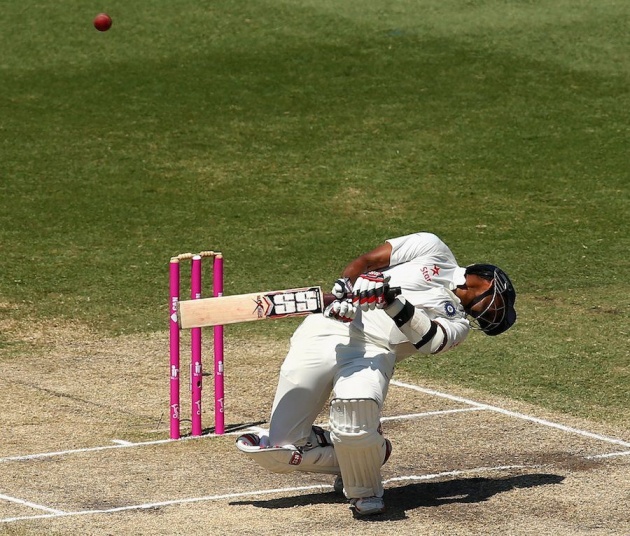Has protective gear resulted in inferior techniques when facing short-pitched bowling, resulting in more batsmen getting hit these days?

Facing the fiery ''Kittu'' Krishna Rao on a bouncy matting wicket back in 1965 or so was easily the most frightening experience of my life, but I managed to survive through sheer greed for batting (a rare treat for a tailender like me unexpectedly promoted to No. 6) and tons of luck. At the other end was an offspinner somewhat better known, for both his bowling and courageous batting down the order for India - S Venkataraghavan. It was a local game in Madras, and Krishna Rao was one of the quickest bowlers we knew, before he was converted to a spinner by the Services team management in the Ranji Trophy.
Venkat's response to that trial by fire was an attacking hundred remarkable for its daring hooks and pulls, often executed perilously close to his nose. Venkat was to demonstrate similar technique and bravery not long afterwards in the Test series against West Indies, with two outstanding innings in the first Test in Bombay - 36 not out and 26. I can never forget the second of those innings. I sat under a tree at my college, listening to the radio commentary while Budhi Kunderan (79) and Venkat added 95 for the ninth wicket after India had lost the first eight for 217. (I had hopelessly torn my new trousers in a motorcycle accident and had to wait till a friend finished attending classes to give me a ride home.) Ironically Venkat was dismissed by rival offspinner Lance Gibbs after he successfully negotiated the fury of Wes Hall and Charlie Griffith with calm assurance.
A decade later I overheard a conversation between Venkat and Derek Underwood during an MCC-South Zone match in Hyderabad, which went somewhat like this:
Venkat: "I once made 37 for Derbyshire against a rampaging Michael Holding."
Underwood: "Not worth it when you think of wife and kids, don't you agree?"
Back in the 1960s, the Ban the Bumper campaign would raise its head every now and then, but the cricket world was largely silent when Nari Contractor was felled by a nasty Charlie Griffith flier and nearly succumbed to the injury. This instance in 1962 was perhaps the one major injury sustained from a short-pitched delivery after the Bodyline series in which the damage was as much psychological and humbling as physical, even if the Australian captain Bill Woodfull believed only one team out there was playing cricket.
In my own experience of listening to commentary, the bloodiest outing for batsmen was the Jamaica Test of April 1976, when Holding and Co pummelled the Indian batsmen after they had put up a splendid show and threatened to repeat their match-winning performance in theTrinidad Test.
Head injuries are an arguably more frequent occurrence in today's cricket than in times gone by. They have come into great focus after Phillip Hughes' tragic death, and more of them have been reported and watched with horror since that cruel accident.
I have always marvelled at how un-helmeted batsmen in international cricket of an earlier era managed to avoid serious injury, especially to the head, during their long careers. I believe it was not until the 1970s that batsmen acquired the skill of swaying out of danger. They were more likely until then to duck under ''bumpers''. Did the batsmen of the pre-helmet era watch the ball better, or display greater technique whether attacking or evading short deliveries, or were they plain lucky to complete their careers without serious head injuries? I am not speaking here of supremely talented batsmen like Viv Richards, Alvin Kallicharran, Clive Lloyd and Roy Fredericks from the West Indies, or other hookers and pullers like Ian Chappell, Doug Walters or Ted Dexter, but of lesser mortals.

I remember India's much-underrated Brijesh Patel once wondering aloud if he might have been a better Test batsman had he enjoyed the protection of a helmet. I tend to agree with that view, as Patel was an otherwise class act whose full blossoming was prevented by a perceived weakness against short-pitched bowling.
Yet there is a theory - very believable too - that modern batsmen are relatively complacent because they are well protected, so they often take the eye off the ball, confident they cannot be hurt seriously. Former Australia coach Bob Simpson once cited the one-time West Indies opener Roy Marshall, who described opening batsmen as madmen who faced the madmen that fast bowlers are.
Who can argue with that? In an article for Sportstar magazine, Simpson went on to say, "They [modern batsmen] wear more protection, so they may look a little braver. But I reckon that protective cladding can positively work against batsmen, especially when it becomes a substitute for technique. Helmets and padding are there to protect against serious injury, not to make a batsman feel invulnerable. There is a temptation to neglect evasive techniques and rely on the armour plating to absorb every hit. Batsmen often take their eyes off the ball, turn their head and let the ball hit them in the knowledge they will suffer no serious damage."
Is Simpson's the last word on why more batsmen seem to sustain head injuries now than in the past? Are the balls harder today? Are bowlers faster, bouncers better directed? Is there more intent on the part of bowlers to frighten if not maim? Perhaps we need the great batsmen of this era to throw light on the subject.
V Ramnarayan bowled offspin for Hyderabad and South Zone in the 1970s. His latest book is Third Man, Recollections from a Life in Cricket



